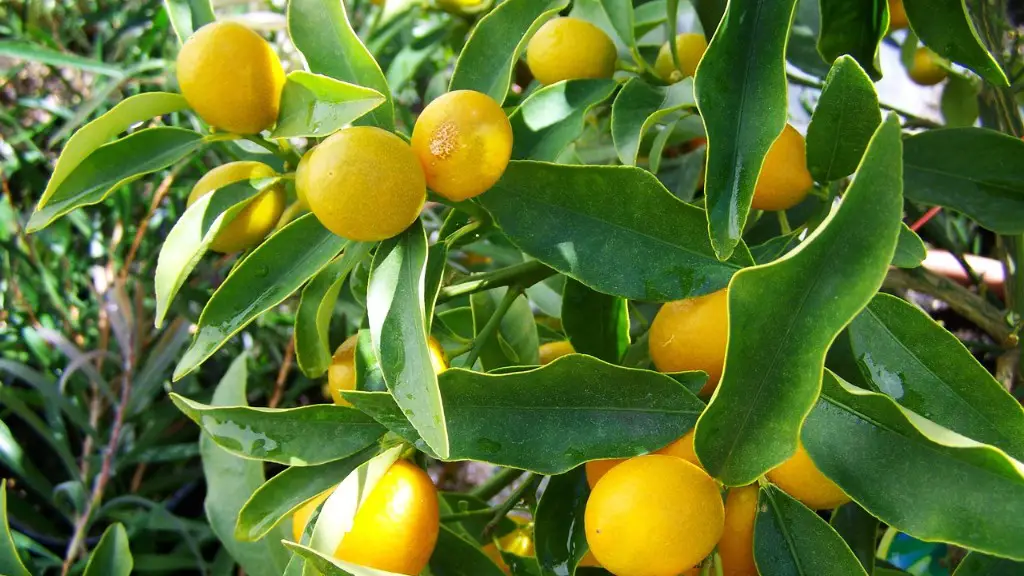One of the most popular home gardening questions that is asked is: How many lemons per tree? To answer this question, we must first understand the growing cycle and cultivation practices of lemon trees. Lemon trees, like all citrus trees, require adequate soil and climate conditions to thrive, and produce lemons with the best flavor and quality. The number of lemons per tree depends on several factors, including the size and age of the tree, its growing conditions, the cultivar of lemon chosen, and the type of pruning that has been employed.
The size of the lemon tree, or rather, its canopy, is a key factor that affects the total number of lemons it can produce. A lemon tree that has a large canopy is capable of producing more lemons than a smaller tree with a smaller canopy. Lemon trees naturally grow to about 10 feet tall, but there are dwarf varieties that produce lemons on small shrubs. Fruit yields can range from a few lemons per year, to hundreds of fruits depending on the size of the tree.
The age of a lemon tree is also an important factor in the number of lemons it can produce. Typically, it takes three to five years for a lemon tree to begin fruiting, while some cultivars may take longer. Once it enters into fruiting, a lemon tree can yield a good harvest for up to fifteen years.
The environment surrounding the lemon tree also affects the number of lemons it can produce. Lemon trees that receive enough sunlight and warm temperatures will generally produce more lemons than lemon trees in less favorable conditions. Good soil fertility and adequate water are essential for lemon tree growth and production. Therefore, lemon trees in areas with nutrient-rich soil and plenty of moisture will tend to yield more fruit than trees in areas where soil and water are scarce.
The type of lemon cultivar selected also impacts the number of lemons per tree. Lemon trees can be divided into three main groups: sweet, sour, and bitter. Sweet-fruited varieties tend to have less lemon per tree, while sour and bitter varieties produce larger crops. Additionally, some lemon cultivars are more tolerant of cooler temperatures, while others are better suited to warmer climates.
The type of pruning employed by the grower also affects the number of lemons per tree. Pruning helps to promote the growth of healthy, vigorous branches capable of producing fruits. When pruning, it is important to keep the center of the tree open to encourage air movement and light penetration. This helps the tree to produce more flowers and fruits. Pruning also helps to reduce the amount of foliage, thus improving the overall health and yield of the tree.
Impact of Soil
The quality of soil has an immense impact on the number of lemons produced per tree. Soil composition affects the texture and water-holding capacity of the soil, both of which are important for good lemons production. Heavy clay soils retain more water than light sandy soils, and this can result in larger lemons per tree. However, sandy soils have better drainage and allow for better air circulation, which can increase the number of lemons produced.
The pH of the soil also has an impact on the number of lemons produced per tree. Lemon trees prefer soils that have a slightly acidic to neutral pH (6.0-7.0). If the pH of the soil is too high or too low, it can cause nutrient deficiencies, poor growth, and an overall decrease in lemons production per tree. Therefore, before planting a lemon tree, have a soil test done to ensure that the pH and fertility are within the optimal range for lemon tree growth and production.
Additionally, the presence of external elements in the soil also affects lemon tree yields. For example, the presence of nitrates, salts, or other chemicals can inhibit lemons production. Therefore, when selecting a location for a lemon tree, make sure that it is free from such contaminates.
Finally, adequate soil fertility is important for good lemon production. Lemon trees need well-drained, fertile soil for best results. The soil should be enriched with organic matter, and nitrogen, potassium, and phosphorus should be added to the soil in the form of fertilizer. This helps to ensure that the tree gets the right amount of nutrients to produce healthy and abundant lemons.
Effects of Pest and Diseases
Unfortunately, lemon trees can be subject to various pests and diseases. These pests and diseases can significantly affect the production of lemons per tree. Pests such as aphids, whiteflies, and mites can weaken the lemon tree and reduce the number of lemons produced. Diseases such as the citrus canker can also decrease the amount of lemons produced by a tree. Therefore, good cultural practices and regular monitoring of your lemon tree can help to minimize the impact of pests and diseases on lemon production.
Other environmental factors that can affect the number of lemons per tree include extreme temperatures, soil compaction, and too much or too little water. To reduce the effects of such factors, make sure that your lemon tree is planted in a location that is well suited for its growth and production needs. Ensure that it has proper drainage and is exposed to adequate sunlight and warm temperatures. Additionally, monitor soil moisture levels, and water the lemon tree only when necessary.
To conclude, the number of lemons produced per tree can vary greatly depending on several factors, including size and age of the tree, its growing conditions, the cultivar of lemon, pruning practices, and the presence of pests and diseases. Therefore, careful selection of growing conditions, cultivar, and cultural methods can help to maximize the yield of your lemon tree and ensure that you get the best returns for your efforts.
Use of Fertilizers
Fertilizers are important for lemon tree growth and production. Lemon trees are heavy feeders and need to be fertilized regularly to ensure healthy growth and maximum production. Organic fertilizers such as compost or manure should be added to the soil or applied around the base of the tree. Additionally, nitrogen, potassium, and phosphorus should be added to the soil to enhance the fertility of the soil and promote the growth of the tree and the production of lemons.
It is also important to choose the right fertilizer for your lemon tree. Organic fertilizers are generally best, as they promote active root growth, are easy to break down, and are relatively slow-release, meaning they release nutrients into the soil over a longer period of time. Chemical fertilizers can be used as well, but it is best to use a balanced blend of nitrogen, phosphorus, and potassium to ensure that the lemon tree receives the right amount of nutrients for optimal growth.
When applying fertilizer, it is important to do so carefully and follow label instructions. If a lemon tree is over-fertilized, it can suffer from nutrient imbalances and excessive vegetative growth, which can in turn lead to lower lemon production. Additionally, fertilizing too often can damage the roots of the tree, resulting in a decrease in lemons production.
In summary, fertilizing your lemon tree is an important step in ensuring healthy growth and maximum lemons production. Careful selection and application of the right fertilizer can help to ensure that the lemon tree gets the right amount of nutrients to produce healthy and abundant lemons.
Harvesting Practices
Harvesting practices can also affect the number of lemons produced per tree. Lemons should be harvested when they are just beginning to show signs of maturity, as this ensures that the fruits have the best flavor and quality. If lemons are left on the tree for too long, they can become overripe and taste bitter. Additionally, overripe lemons can drop to the ground, leading to a decrease in overall lemon production.
When harvesting lemons, it is important to use proper techniques to ensure that the tree is not damaged. Wielding pruning shears or a sharp knife, cut the lemon near the stem, leaving a short portion of the stem in place. This helps to prevent damage to the tree, as well as any bacteria or fungi from entering through the wound. Additionally, be sure to avoid vigourous shaking and pulling of the fruits, as this can lead to bark abrasion and overall decrease in lemon production.
Moreover, any damaged or diseased lemons should be removed immediately to prevent the spread of the disease and to maintain the overall health of the tree. When harvesting the lemons, always wear gloves to avoid any contact with the tree’s sap, as this can cause skin irritation and irritation to the eyes if it comes into contact with them.
To sum up, harvesting lemons should be done carefully, using proper techniques to avoid damaging the tree and to maintain the lemon production. Additionally, any damaged or diseased lemons should be removed immediately, and gloves should be worn to protect from any contact with the sap.
Care Post Harvesting
Careful post-harvesting practices can also help to increase the production of lemons per tree. After harvesting the lemons, make sure to store them in a cool, dry place as soon as possible. This helps to prevent any bacterial or fungal growth and spoilage. Additionally, the lemons should be kept in a sealed container to help protect them from pests and disease.
It is also important to rotate the lemons regularly to prevent the fruits from becoming overripe. Lemons that are kept at the same temperature tend to ripen faster, and this can lead to a decrease in lemon production. As such, make sure to move the lemons to cooler or warmer locations according to the ambient temperature to promote even ripening.
Additionally, it is important to inspect the lemons regularly. Check for any signs of disease, such as discolored spots, soft spots, or mold, and remove these fruits immediately to prevent the spread of the disease. This will help to ensure that your lemon tree remains healthy and continues to produce a good yield.
Finally, the lemon tree should be watered and fertilized regularly after harvesting. Adequate water and nutrients are essential for good lemon production, and so it is important to provide the tree with the necessary resources it needs to stay healthy and produce abundant lemons.
In conclusion, proper post-harvesting practices such as storage, rotation, and inspection of lemons, as well as regular watering and fertilizing of the lemon tree, can help to promote healthy growth and increase the production of lemons per tree. Consequently, following these practices can help to ensure that you get the best returns for your efforts in lemons production.


